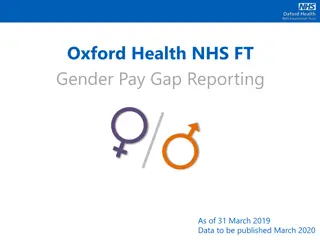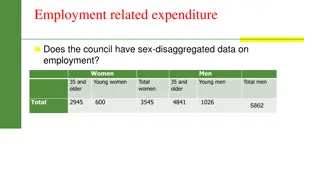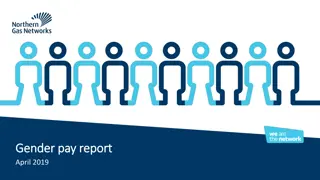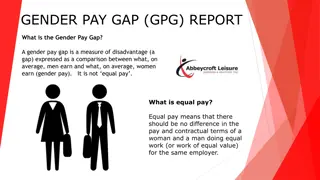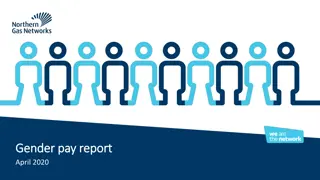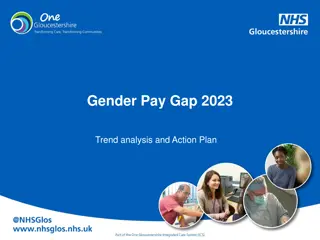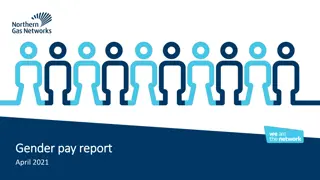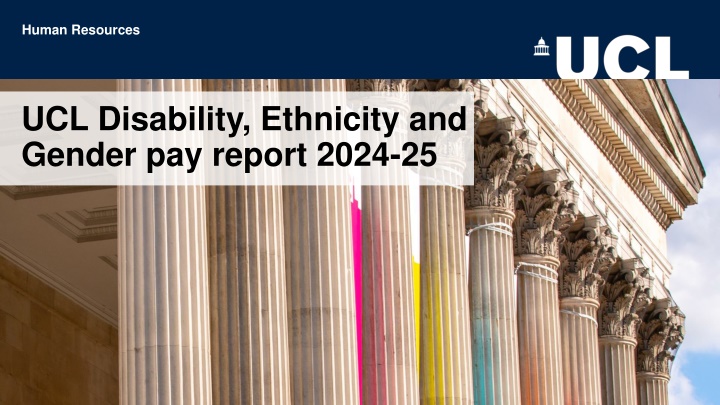
UCL Gender Pay Gap Report 2024-25 Analysis
Explore UCL's latest Gender Pay Gap Report for 2024-25, highlighting increases in the gap but also improvements in gender diversity at senior levels, reductions in ethnicity pay gaps, and strides in disability pay equality. Learn about the mean and median gaps, quartile positioning data, and efforts to address disparities based on gender, ethnicity, and disability.
Download Presentation

Please find below an Image/Link to download the presentation.
The content on the website is provided AS IS for your information and personal use only. It may not be sold, licensed, or shared on other websites without obtaining consent from the author. If you encounter any issues during the download, it is possible that the publisher has removed the file from their server.
You are allowed to download the files provided on this website for personal or commercial use, subject to the condition that they are used lawfully. All files are the property of their respective owners.
The content on the website is provided AS IS for your information and personal use only. It may not be sold, licensed, or shared on other websites without obtaining consent from the author.
E N D
Presentation Transcript
Human Resources UCL Disability, Ethnicity and Gender pay report 2024-25
Foreword This report outlines UCL s latest pay gap position with data taken at the end of March 2024. The report shows that, after consecutive years of narrowing, this year our gender pay gaps have increased. However, this obscures the fact that the proportion of female staff has increased in our senior grades (8-10), relative to male staff. Recruitment and promotions outcomes continue to increase female staff in those grades. The gap increase is driven by an increased number of female staff, primarily Postgraduate Teaching Assistants (PGTAs), within the lower pay quartile. Positively, in contrast to last year, we have reduced our mean and median ethnicity pay gap, while also reducing the number of staff who have unknown ethnicity following a specific exercise to tackle that. The proportion of Black, Asian and Minority Ethnic staff in grade 8, grade 9 and grade 10 have all increased within the period. The report also outlines our declared disability gap for the third time and, while the gaps remain substantial, we are very pleased to see a significant reduction in the mean and median disability pay gaps since last year's report. This followed last year's reduction. We remain one of the few organisations to report this gap, but others are now starting to report their gaps, and this will make it easier to benchmark going forward. Donna Dalrymple, Chief People Officer This year both the mean and median gender pay gaps are likely to again to be amongst the lowest in the Russell Group. We can see that the proportion of female staff at each of the grades above the median UCL earnings (grades 8-10) is increasing and reward mechanisms, such as the senior promotions process, continue to increase gender diversity at senior levels. In 2024, 49% of senior promotions to grade 9 and 10 academic positions were female, significantly above the current proportion of female academics in these grades. Furthermore, 46% of the academics newly promoted to professor were female, another record which will significantly increase the proportion of female professors at UCL. Distribution of staff between the grades continues to be the overwhelming reason for overall gaps as shown by the quartile positioning data later in the report. It remains the case that there are no substantial equal pay gaps in grades 1- 9 or with the senior grade 10 pay bands. We have summarised equal pay findings later in this report, however it is important to note that equal pay is not causing our overall pay gaps. We remain committed to addressing gender, ethnicity and disability pay gaps over the coming years. We will continue to support the career development of women, Black, Asian and Minority Ethnic (BAME) and disabled staff to increase their representation at our highest grades.
Gender pay gap analysis Gender pay focuses on the differential between the average (median and mean*) salary of all women and men at UCL. The mean gap at UCL now stands at 13.2% and the median at 6.8%- rises from the same point last year. This remains significantly below averages in wider society. As a reference point the ONS outlined that the median gap for all staff in the UK was 13.1% in April 2024. Comparing these figures with 2023 reports would mean that UCL has the lowest mean gap and second lowest median gap amongst the Russell group. *The mean is calculated by adding up all of the wages of employees and dividing that figure by the number of employees. The median is the number that falls in the middle of a range when everyone s wages are lined up from smallest to largest.
Gender quartile positioning The primary reason for the increase in the gender pay gap is the 3% increase of female staff in the low pay quartile. This is driven by an increase in the proportion of female PGTAs relative to male PGTAs over the period. Aside from that there have been only very minor changes to the proportion of male and female staff in other quartiles. *Percentages in brackets represent last year's figures
Gender - Increase/decrease of employees in grades since 2023 The median salary at UCL is near the top of grade 7. At higher grades we can see that there has been an increase in the proportion of female staff compared to males. In isolation that would have reduced the gap. The increase in female staff at grade 10 is particularly welcome. However, just below the median at grade 7 there has been a small increase in the proportion of women relative to men. As per the case last year there has been a rise in grade 6 PGTAs and that spike has been predominantly female. PGTAs are engaged on fractional employment contracts. PGTAs have been excluded from the table due to the high degree of fluctuation each year. Change in number of female/ male staff in each grade over the period Excl. PGTAs
Adjustment in female staff numbers needed at each grade to eradicate pay gap This chart shows the extent of changes needed to female staff numbers at each grade. Overall, the proportion of female staff across UCL has risen slightly (1%). In terms of distribution between grades the picture is close to last year. To note that the proportion of female staff at grade 8 has increased but overall, there would need to be large decreases (nearly 400) in the numbers of female staff at grades 6 and 7 to significantly affect the gaps. Similarly, while the number of female professors has increased, it would still require 278 extra female professors (marginally less than last year) to have an even split.
Gender pay bonus reporting As in previous years UCL needs to categorise clinical excellence awards (CEAs) as bonus payments. UCL pays very few one-off payments and over 88% of them are CEAs. These awards are mandated by the NHS and much larger than any bonuses agreed internally. As a larger proportion of our senior clinical staff in receipt of the awards are male, it substantially distorts our data. As such, with CEAs included, the average bonuses are high and heavily in favour of men. Including the CEAs, bonuses were paid to 0.6% of female staff and 1.4% of male staff Pay gap in bonuses paid Pay gap in bonuses paid excluding Clinical Excellence Awards (CEAs) Where CEAs are excluded (lower graph), to include only the payments UCL has control over, bonuses are much smaller and higher average amounts are paid to female staff- which follows the trend from previous years.
Ethnicity pay gap analysis After a period of rising, the mean gap this year has decreased and is now 14.8% and the median gap has reduced again- this year quite substantially from 10% to 9.3%. The proportion of Black, Asian and Minority Ethnic and white staff between the grades and the quartiles remains very similar to previous years. As with gender, Black, Asian and Minority Ethnic staff are underrepresented at senior levels which continues to be a reason for the ethnicity pay gaps. As was the case last year, there has been a marginal increase in the proportion of staff in the senior grades (8-10) who are Black, Asian and Minority Ethnic, which is encouraging. UCL does not have a fairness issue in terms of equal pay for work of equal value. We have checked equal pay this year and again this is not driving the overall ethnicity gap. *The mean is calculated by adding up all of the wages of employees and dividing that figure by the number of employees. The median is the number that falls in the middle of a range when everyone s wages are lined up from smallest to largest
Ethnicity quartile positioning Following the action included in last year's report, initiatives have been taken forward to reduce the number of unknowns and the data shows that there has been a significant reduction in staff with unknown ethnicity. Correspondingly there has been an increase in the proportion of Black, Asian and Minority Ethnic staff and White staff. However, there has been a significantly higher increase in the proportion of White staff in the lower two pay quartiles. There has also been a minor 1% increase in the proportion of Black, Asian and Minority Ethnic staff in the higher pay quartile with a corresponding 1% decrease in the proportion of white staff in that quartile. These two points combined are the reason that the ethnicity pay gaps have reduced in the period. *Percentages in brackets represent last year's figures
Ethnicity analysis % increase/decrease in population by grade since 2023 The table shows the change in proportion of staff at each grade from last year. Encouragingly, the same as last year, we can see the percentage of Black, Asian and Minority Ethnic Staff within grades above median (8-10) has increased more than the proportion of white staff in the same grades However, at grade 7 (immediately below median) the population of Black, Asian and Minority Ethnic staff has increased while the proportion of white staff remains marginally reduced. The ethnicity pay gap is calculated by considering the differences between the pay of Black, Asian and Minority Ethnic staff and white staff only. Depending on the proportion of unknown staff who are white or Black, Asian and Minority Ethnic the gap would shrink or widen.
Adjustment in Black, Asian and Minority Ethnicstaff needed at each grade to eradicate pay gap Like gender, Black, Asian and Minority Ethnic staff are underrepresented at grades 9 and 10. An even larger issue is that Black, Asian and Minority Ethnic staff are overrepresented in grades below the average UCL salary. There is still a significant over representation (181) of Black, Asian and Minority Ethnic staff at grade 7. Progression from this level over the median remains important, particularly for research staff who have a promotions process.
Pay gap declared disability vs no declared disability This is the third year in which UCL has published its pay gaps between the average salaries of staff who have disclosed a disability and those who have not declared a disability. The gaps remain substantial, but we are pleased that there has been a significant reduction in both the mean and median gap, following reductions last year. The distribution of staff between the grades is again the primary reason for the remaining gaps. UCL still remains one of few organisation to report their disability pay gap which makes it difficult to benchmark against others, but more organisations are starting to release similar data which will allow better comparisons in the future. *The mean is calculated by adding up the wages of employees and dividing that figure by the number of employees. The median is the number that falls in the middle of a range when everyone s wages are lined up from smallest to largest
Declared disability quartile positioning As per the case last year the quartile positioning shows the clear drop of disabled staff as we move up the grading structure. Disabled staff are much more likely to be within the low pay quartile (grades 1-6) where 17% of staff have a declared disability vs. the top pay quartile (grades 9 and 10) where only 8% of staff have a declared disability. In contrast to last year, positively the proportion of unknowns has reduced and this in turn has revealed a much larger proportion of non-disabled staff within the lower pay quartiles, which then led to significant reductions in the mean and median disability pay gaps. *Percentages in brackets represent last year's figures
Declared disability analysis % increase/decrease in population by grade since 2023 The table shows the change in proportion of staff at each grade from last year. Encouragingly, the same as last year, we can see the percentage of staff with a declared disability has risen above the median (grades 8-10). Below the median, there have been larger increases in the proportion of non- disabled staff (as unknowns have reduced). The effect of these two issues has led to the disability pay gap reducing.
Declared disability adjustment in staff numbers needed at each grade to eradicate pay gap Aside from grade 9, staff with declared disability continue to be underrepresented in senior grades. Promotion and recruitment of staff with disabilities at grade 8 and upwards should remain a focus. In terms of representation at grades below the median, grade 7 is the grade where staff with disabilities are proportionately overrepresented. We need to remain focused on progression of these staff, in particular for researchers where there is an established promotion process.
Equal pay- hourly pay averages within grades Equal pay focuses on pay within the same grade and is therefore very different to an overall gender or ethnicity pay gap. However, as part of monitoring our overall pay gaps we also monitor equal pay- looking at jobs in each grade. A minus figure denotes female, Black, Asian and Minority Ethnic or disabled staff being paid more in the grade. Mean GAP Gender Ethnicity Disability 1 0.30% n/a n/a 2 n/a n/a n/a 3 n/a n/a n/a There will always be marginal variance in the pay of different groups within pay grades and this is prone to fluctuate over time. Here we can see that all the gaps in any grade are under 3%, aside from grade 10-4 in terms of female staff. In a general sense there is a tendency for male staff to be paid marginally more than female staff in most grades and for Black, Asian and Minority Ethnic Staff staff to be paid more than white staff in most grade. However, these are only marginal differences, and neither is contributing to any overall pay gap. 4 0.90% -0.60% n/a 5 1.50% -1.60% 2.80% 6 -0.50% 0.40% 2.20% 7 0.50% 1.00% 2.40% 8 1.10% -0.60% 1.60% 9 2.00% -2.20% 0.00% 10 PS 1.70% -2.30% -3.00% 10 ACAD 2.50% -0.80% In order to analyse only robust, meaningful data, where there are less than 10 people with a protected characteristic in each grade, we have not included the results in the table shown. We typically analyse pay within each professorial grade 10 band, but in terms of ethnicity and disability we have included a figure for grade 10 Professional Services staff and all the professorial bands combined. This is due to having relatively low numbers of staff when we look within professorial bands by ethnicity or disability. UCL.Grade 10-1 2.10% UCL.Grade 10-2 1.00% UCL.Grade 10-3 -0.90% UCL.Grade 10-4 3.90%
Actions which have narrowed UCLs gaps in the period As part of a commitment to remain an employer of choice UCL has undertaken a series of positive initiatives to reduce pay gaps, some of which are outlined below: Academic promotions Since the launch of our academic careers framework in 2017 there has been a significant increase in the proportion of female academics promoted to senior levels after each promotion round. Last year 49% of promoted staff and 46% of all new professors were female (35% of the professoriate are female). Moreover, 15% of promoted staff were Black, Asian and Minority Ethnic staff , including 11% of new professors. This will marginally increase the proportion of Black, Asian and Minority Ethnic staff in the high pay quartile. Pay strategy UCL s approach to London allowance in the new pay and reward strategy did have the overall effect of reducing our gender pay gap (by circa 1%) in this period. Recruitment Due to the simplified application process and expanded routes to market strategy continuing to remove barriers to entry, our progress on hiring more Black, Asian and Minority Ethnic staff and more disabled staff continued. This helped us to increase representation of those groups across our grades but particularly at our senior levels. Training was rolled out with hiring managers on reasonable adjustment requests to improve our responsiveness to supporting disabled applicants. Over 3,500 staff involved in recruitment have completed the Fair and Inclusive Recruitment training programme. Reduce the proportion of staff with unknown ethnicity and disability status. Urgent work was undertaken by the EDI team to reduce the number of unknowns through a data disclosure campaign, and this has had a positive effect on the data, particularly in terms of this reporting period. Where unknowns have reduced it has had the effect of lowering gaps in the period.
Actions going forward Review of Early Career Researcher promotion process: As reported last year Research Culture and HR have reviewed the ECR promotion processes. Initial recommendations have been produced and are scheduled to be developed and tested with Engineering, as the pilot faculty, in the first half of 2025. The Reasonable Adjustments sub-group of the Disability Equality Implementation Group to develop actions to ensure that reasonable adjustments for staff are implemented fairly, consistently and effectively and meet the needs of Disabled and Neurodivergent staff. The group will: 1.Review the current processes for Reasonable Adjustments for both staff and students (including PEEPs). Oversee the development of a Reasonable Adjustments process for built environment works. 2.Consider how all reasonable adjustments (including PEEPS) are funded by UCL. 3.Consider improvements to all reasonable adjustments processes at UCL. 4.Consider a communications package on reasonable adjustments (including PEEPs) Faculty splits of the data is being produced and will be shared with Faculty leadership in the first half of 2025. This will enable local actions to be developed. Training- Every academic year approximately 150 colleagues participate one of three positive action leadership programmes : Senior Women in Leadership programme (grades 8&9) Women in Leadership programme (grades 6&7) Emerging Leaders programme for Black, Asian and Minority Ethnic staff (6&7) Going forward we will be conducting an assessment to understand the impact of these programmes on promotion/progression so we can measure this year on year. We will also be enhancing the content to align it more to navigating promotions and career development opportunities.
Actions going forward As part of the new EDI strategy and, based on the significant data obtained from our new recruitment system, we will be defining a recruitment strategy and associated actions to improve Black, Asian and Minority Ethnic staff representation, particularly in our academic roles. We will increase representation of women in senior roles and increase representation of disabled staff across all grades by both consolidating the improvements made through removing barriers to entry in the application process and expansion of routes to market. We will also further embed targeted positive action programmes such as Accelerate to Leadership to increase numbers going through the scheme. The strategy will include quarterly reporting on progress to allow timely interventions and course correcting. Run another data disclosure campaign in 2025-26 to further improve the quality of our pay gap and wider EDI reporting data, particularly in relation to disability data. A tracked positive action pilot in partnership with the EDI team and our hiring community to launch by the end of 2025 for defined identified academic vacancies. We will be measuring all interventions in this pilot and their impact and looking at how we can roll out learnings from this more broadly. Looking further forward, UCL will undertake a review and refresh of the Academic Careers Framework (ACF). Since it was introduced the ACF has helped deliver much more diverse outcomes than the criteria used previously. However, EDI considerations will continue to be a critical part of the review over the coming period.




